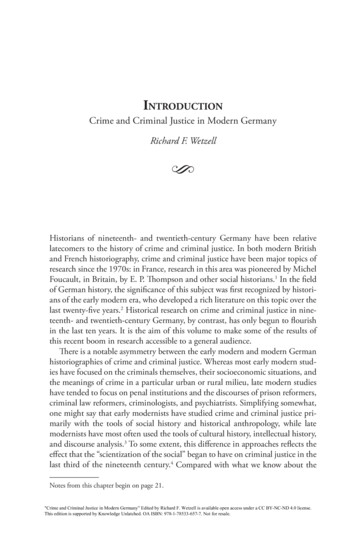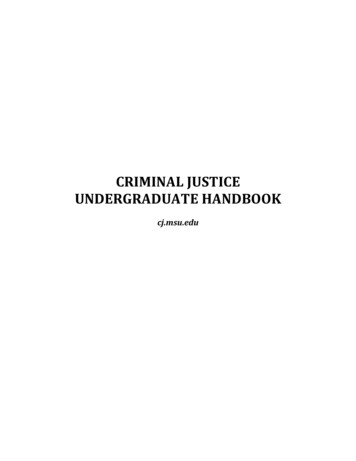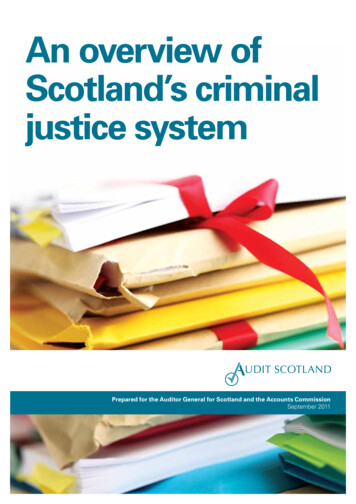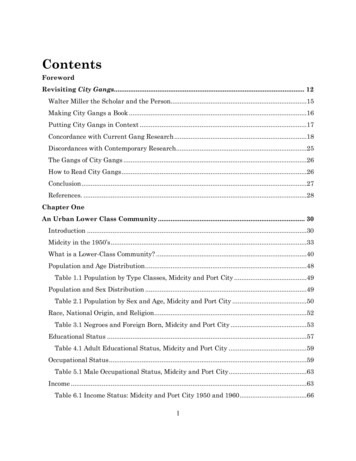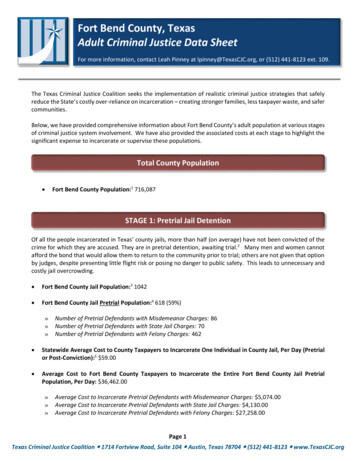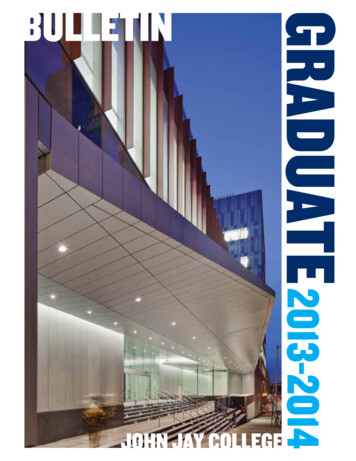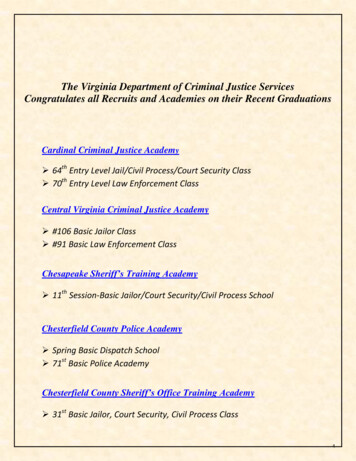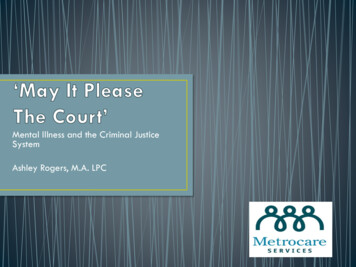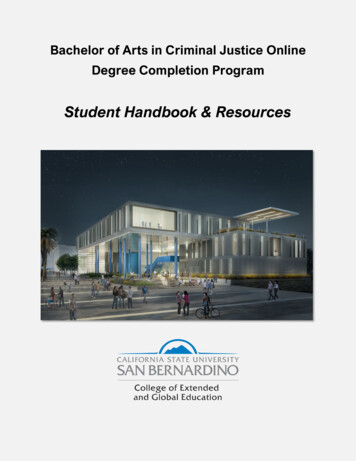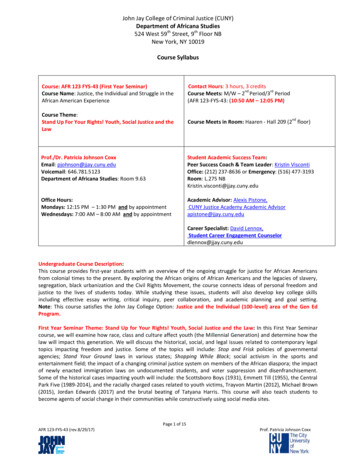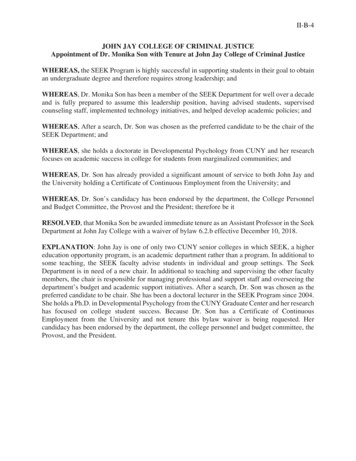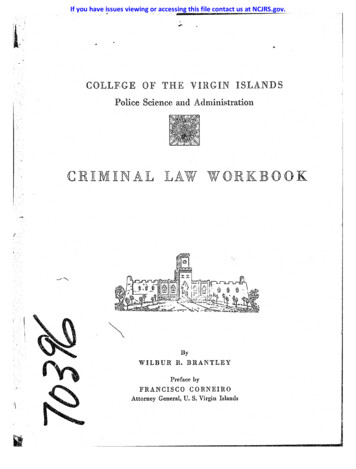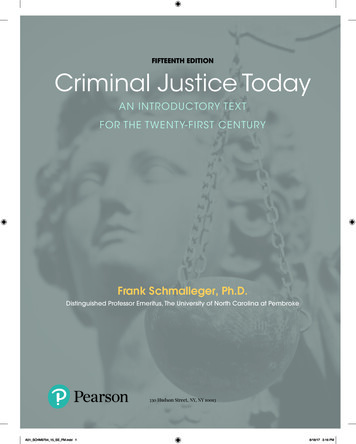
Transcription
iGLOSSARYFIFTEENTH EDITIONCriminal Justice TodayAN INTRODUCTORY TEXTFOR THE TWENTY-FIRST CENTURYFrank Schmalleger, Ph.D.Distinguished Professor Emeritus, The University of North Carolina at Pembroke330 Hudson Street, NY, NY 10013A01 SCHM9754 15 SE FM.indd 18/18/17 3:16 PM
Vice President, Portfolio Management: Andrew GilfillanPortfolio Manager: Gary BauerEditorial Assistant: Lynda CramerSenior Vice President, Marketing: David GesellField Marketing Manager: Thomas HaywardDirector, Digital Studio and Content Production: Brian HylandManaging Producer: Cynthia ZonneveldContent Producer: Holly ShufeldtManager, Rights Management: Johanna BurkeOperations Specialist: Deidra SmithCreative Digital Lead: Mary SienerManaging Producer, Digital Studio: Autumn BensonContent Producer, Digital Studio: Maura BarclayFull-Service Management and Composition: Integra SoftwareServices, Ltd.Full-Service Project Manager: Abinaya RajendranCover Design: Studio MontageCover Photo: icedmocha/Shutterstock; 3D creation/Shutterstock;View Apart/Shutterstock; nobeastsofierce/Shutterstock; Jiri Hera/Shutterstock; Vectomart/Shutterstock.Printer/Binder: LSC Communications, Inc.Cover Printer: Phoenix Color/HagerstownText Font: Bembo MT Pro 10/13Credits and acknowledgments for content borrowed from other sources and reproduced, with permission, in this textbook appear on the appropriate page within the text.Acknowledgements of third party content appear on page with the borrowed material, which constitutes an extension of this copyright page.Unless otherwise indicated herein, any third-party trademarks that may appear in this work are the property of their respective owners and anyreferences to third-party trademarks, logos or other trade dress are for demonstrative or descriptive purposes only. Such references are not intendedto imply any sponsorship, endorsement, authorization, or promotion of Pearson’s products by the owners of such marks, or any relationshipbetween the owner and Pearson Education, Inc. or its affiliates, authors, licensees or distributors.The Internet addresses listed in the text were accurate at the time of publication. The inclusion of a website does not indicate an endorsementby the author or Pearson Education. Pearson Education does not guarantee the accuracy of the information presented at these sites.Copyright 2019, 2017, 2015 by Pearson Education, Inc. or its affiliates. All Rights Reserved. Printed in the United States of America.This publication is protected by copyright, and permission should be obtained from the publisher prior to any prohibited reproduction, storage ina retrieval system, or transmission in any form or by any means, electronic, mechanical, photocopying, recording, or otherwise. For informationregarding permissions, request forms and the appropriate contacts within the Pearson Education Global Rights & Permissions department, pleasevisit www.pearsoned.com/permissions/.Many of the designations by manufacturers and sellers to distinguish their products are claimed as trademarks. Where those designations appear inthis book, and the publisher was aware of a trademark claim, the designations have been printed in initial caps or all caps.Library of Congress Cataloging-in-Publication DataSchmalleger, Frank, author.Criminal justice today : an introductory text for the twenty-first century / Frank Schmalleger, Ph.D.Distinguished Professor Emeritus, The University of North Carolina at Pembroke.Fifteenth Edition. Hoboken : Pearson, [2017] Revised edition of the author’s Criminal justicetoday, [2017]LCCN 2017020520 ISBN 9780134749754 (alk. paper) ISBN 0134749758 (alk. paper) ISBN 9780134833828 (loose leaf) ISBN 0134833821 (loose leaf)]LCSH: Criminal justice, Administration of—United States. Criminal procedure—United States.LCSH: LCC HV9950 .S35 2017b DDC 364.973—dc23LC record available at https://lccn.loc.gov/2017020520117Paper Bound: ISBN 13: 978-0-13-474975-4ISBN 10:0-13-474975-8Loose leaf: ISBN 13: 978-0-13-483382-8ISBN 10:0-13-483382-1A01 SCHM9754 15 SE FM.indd 28/18/17 3:16 PM
This book is dedicated to my beautiful wife,Ellen “Willow” Szirandi Schmalleger, my true companion,whose wonderful, happy, and free spiritis a gift to all who know her.A01 SCHM9754 15 SE FM.indd 38/18/17 3:16 PM
Brief ContentsPART 1 Crime in America1Chapter 1 What is Criminal Justice?Chapter 2 The Crime Picture231Chapter 3 The Search for Causes 72Chapter 4 Criminal LawPART 2 Policing110139Chapter 5 Policing: History and Structure140Chapter 6 Policing: Purpose and OrganizationChapter 7 Policing: Legal Aspects196Chapter 8 Policing: Issues and ChallengesPART 3 Adjudication165242283Chapter 9 The Courts: Structure and ParticipantsChapter 10 Pretrial Activities and the Criminal TrialChapter 11 Sentencing320350PART 4 Corrections397Chapter 12 Probation, Parole, and ReentryChapter 13 Prisons and JailsChapter 14 Prison Life284398427472PART 5 Special Issues513Chapter 15 Juvenile JusticeChapter 16 Drugs and Crime514540Chapter 17 Terrorism, Multinational Criminal Justice, and Global IssuesChapter 18 High-Technology Crimes576612ivA01 SCHM9754 15 SE FM.indd 48/18/17 3:16 PM
ContentsPrefacexxvAcknowledgmentsxxviiiAbout the Author xxxiPART ONECrime in America Chapter 1 What is Criminal Justice?Introduction123A Brief History of Crime in America4The Theme of This Book 7FREEDOM OR SAFETY? YOU DECIDE Clarence Thomas Says: “Freedom Means Responsibility” 9Criminal Justice and Basic Fairness 10CJ NEWS Surveillance Technology Has Been Blanketing the Nation Since 9-11American Criminal Justice: System and FunctionsThe Consensus ModelThe Conflict Model131314American Criminal Justice: The ProcessInvestigation and ArrestPretrial Activities12151516EVIDENCE-BASED JUSTICE REINVESTMENT Data-Driven, Cost-Efficient Criminal try21Due Process and Individual Rights21The Role of the Courts in Defining Rights22The Ultimate Goal: Crime Control through Due ProcessEvidence-Based Practice in Criminal Justice 18CJ CAREERS Careers in Criminal JusticeThe Start of Academic Criminal Justice2425Multiculturalism and Social Diversity in Criminal JusticeSummary27Key Terms28232325Questions for Review 28Questions for Reflection 28Notes28Chapter 2 The Crime PictureIntroduction3132Crime Data and Social Policy32The Collection of Crime Data33vA01 SCHM9754 15 SE FM.indd 58/18/17 3:16 PM
viCONTENTSThe UCR/NIBRS Program33Development of the UCR Program33The National Incident-Based Reporting SystemHistorical Trends3537UCR/NIBRS in Transition41Part I Offenses 42 CJ NEWS “Flash Robs”—A Social Media Phenomenon CJ ISSUES Race and the Criminal Justice SystemPart II Offenses485053FREEDOM OR SAFETY? YOU DECIDE Can Citizens Have Too Much Privacy?The National Crime Victimization SurveyComparisons of the UCR and NCVS545556Special Categories of Crime 57Crime against Women57Crime against the Elderly 58CJ ISSUES Gender issues in Criminal JusticeHate Crime5960Corporate and White-Collar CrimeOrganized CrimeGun Crime63Drug Crime64Cybercrime646162 CJ ISSUES Gun Control CJ NEWS Most Americans Favor Legalizing MarijuanaTerrorism656667Summary67Key Terms68Questions for Review 68Questions for Reflection 68Notes68Chapter 3 The Search for Causes 72Introduction73Criminological Theory74Classical and Neoclassical Theory76Cesare Beccaria: Crime and PunishmentJeremy Bentham: Hedonistic CalculusThe Neoclassical Perspective7979Franz Joseph Gall: PhrenologyA01 SCHM9754 15 SE FM.indd 67878Social Policy and Classical TheoriesEarly Biological Theories78798/18/17 3:16 PM
CONTENTSCesare Lombroso: AtavismCriminal Familiesvii8081William Sheldon: Somatotypes81Social Policy and Early Biological TheoriesBiosocial Theories8282The Gender Ratio ProblemChromosome Theory8283Biochemical Factors and ImbalancesHeredity and HeritabilitySocial Policy and Biological TheoriesPsychological Theories84858686Behavioral Conditioning86Freudian Psychoanalysis 86Psychopathology and CrimeThe Psychotic Offender8788Trait Theory 88Psychological Profiling89Social Policy and Psychological TheoriesSociological TheoriesSocial Ecology TheoryAnomie Theory9091Subcultural Theory 91CJ NEWS Evidence of “Warrior Gene” May Help Explain ViolenceSocial Policy and Sociological TheoriesSocial Process Theories9393CJ ISSUES The Physical Environment and CrimeRestraint TheoriesLabeling Theory9293Differential Association Theory 9090949596Social Development and the Life Course97Conflict Theories 99Radical Criminology100Peacemaking Criminology101Social Policy and Conflict TheoriesEmergent Perspectives102Feminist Criminology102Postmodern CriminologySummary104Key Terms105Key Cases105102104Questions for Review 105A01 SCHM9754 15 SE FM.indd 78/18/17 3:16 PM
viiiCONTENTSQuestions for Reflection 106Notes106Chapter 4 Criminal LawIntroduction111The Nature and Purpose of LawThe Rule of LawTypes of Law 110111112112CJ NEWS Politicians Who Violate the “Rule of Law” Get Tough Prison SentencesCriminal Law114Statutory LawCivil Law114115Administrative LawCase Law115115General Categories of 16116116FREEDOM OR SAFETY? YOU DECIDE Should Violent Speech Be Free Speech?Espionage117118Inchoate Offenses118General Features of Crime118The Criminal Act (Actus Reus)A Guilty Mind (Mens Rea)Concurrence118120121Other Features of Crime121Elements of a Specific Criminal OffenseThe Example of Murder123123The Corpus Delicti of a Crime124Types of Defenses to a Criminal cedural Defenses 134Summary136Key Terms136Key Cases137Questions for Review 137Questions for Reflection 137Notes137A01 SCHM9754 15 SE FM.indd 88/18/17 3:16 PM
CONTENTSPART TWOPolicing 139Chapter 5 Policing: History and StructureIntroductionix140141Historical Development of the Police141English Roots 141The Early American Experience143The Last Half of the Twentieth CenturyEvidence-Based Policing145146American Policing Today: From the Federal to the Local LevelFederal Agencies150The Federal Bureau of Investigation 149150CJ NEWS The FBI’s Next Generation Identification System153State Agencies 153Local Agencies 154CJ NEWS NYPD Permits Wearing of Turban, Beards, by Sikh OfficersPrivate Protective Services155156EVIDENCE-BASED JUSTICE REINVESTMENT Cost-Efficient Policing 157Integrating Public and Private Security 159CJ CAREERS 160ETHICS AND PROFESSIONALISM ASIS International Code of EthicsSummary162Key Terms163161Questions for Review 163Questions for ReflectionNotes163163Chapter 6 Policing: Purpose and OrganizationIntroduction165166The Police Mission 166Enforcing the Law166Apprehending OffendersPreventing Crime167Predicting Crime168Preserving the PeaceProviding Services169170Operational StrategiesPreventive Patrol170170Routine Incident ResponseEmergency ResponseA01 SCHM9754 15 SE FM.indd 91671711718/18/17 3:16 PM
xCONTENTSCriminal InvestigationProblem Solving173Support Services173171EVIDENCE-BASED JUSTICE REINVESTMENT Policing in an Economic DownturnManaging Police DepartmentsPolice Organization and StructureChain of CommandPolicing Styles174175175175175The Watchman Style of PolicingThe Legalistic Style of PolicingThe Service Style of Policing177178178Police–Community Relations178FREEDOM OR SAFETY? YOU DECIDE Police Body-Worn Cameras: The Good and the BadTerrorism’s Impact on Policing 183CJ EXHIBIT 6–1 The President’s Task Force on 21st Century PolicingIntelligence-Led Policing and AntiterrorismInformation Sharing and AntiterrorismFusion Centers186187CJ CAREERS Police Officer187188Ethnic and Gender Diversity in PolicingWomen as Effective Police Officers 188190CJ ISSUES Trust and Diversity in Law EnforcementSummary192Key Terms192Questions for Review190192Questions for ReflectionNotes192193Chapter 7 Policing: Legal AspectsIntroduction196197The Abuse of Police Power197A Changing Legal ClimateIndividual Rights198199Due Process RequirementsSearch and Seizure199200The Exclusionary Rule200FREEDOM OR SAFETY? YOU DECIDE Liberty Is a Double-Edged SwordJudicial Philosophy and the U.S. Supreme Court 184185The National Criminal Intelligence Sharing Plan 179CJ ISSUES Plain-View RequirementsDetention and ArrestA01 SCHM9754 15 SE FM.indd 102022042082118/18/17 3:16 PM
CONTENTSSearches Incident to Arrest212Emergency Searches of PersonsVehicle Searches215215 CJ NEWS Supreme Court Says Police Need Warrants before Searching Cell Phones CJ CAREERS Patrol OfficerSuspicionless SearchesThe Intelligence Function220221221Police Interrogation222The Right to a Lawyer at Interrogation 216219219High-Technology SearchesInformantsxi224Suspect Rights: The Miranda Decision225CJ ISSUES The Miranda Warnings227Gathering Special Kinds of Nontestimonial Evidence 230FREEDOM OR SAFETY? YOU DECIDE Policing in the Age of Social MediaElectronic Eavesdropping231232 CJ NEWS Supreme Court Says Police Need Warrant for GPS Tracking CJ ISSUES The USA PATRIOT Act of 2001 and the USA PATRIOT Improvement and Reauthorization Act of 2005 235Summary237Key Terms238Key Cases238233Questions for Review 238Questions for Reflection 238Notes238Chapter 8 Policing: Issues and ChallengesIntroduction243Police Personality and Culture 242243CJ ISSUES Rightful Policing 245Corruption and Integrity246Money—The Root of Police Evil?Building Police Integrity248249Drug Testing of Police EmployeesProfessionalism and Ethics250251ETHICS AND PROFESSIONALISM The Law Enforcement Code of EthicsETHICS AND PROFESSIONALISM The FBI OathEducation and Training253Recruitment and SelectionThe Dangers of Police WorkViolence in the Line of Duty254255256Risk of Disease and Infected EvidenceA01 SCHM9754 15 SE FM.indd 112522532568/18/17 3:16 PM
xiiCONTENTSStress and Fatigue among Police Officers258FREEDOM OR SAFETY? YOU DECIDE Religion and Public SafetyPolice Use of ForceDeadly Force 260262CJ EXHIBIT 8–1 Taking Policing to a Higher StandardLess-Lethal Weapons 263265CJ ISSUES The President’s Task Force on 21st Century PolicingDiscretion and the Individual Officer266Racial Profiling and Biased Policing267 259266CJ NEWS Is the Video Recording of Police Activity in a Public Place Legal?Racially Biased Policing268270FREEDOM OR SAFETY? YOU DECIDE Was the NYPD’s Monitoring of Muslim Groups a Form of Religious Profiling? 271Police Civil Liability272Common Sources of Civil Suits 272CJ ISSUES Investigating Crime in a Multicultural Setting273FREEDOM OR SAFETY? YOU DECIDE Law Enforcement and Data EncryptionFederal LawsuitsSummary278Key Terms278Key Cases278275276Questions for Review 279Questions for Reflection 279Notes279PART THREE Adjudication283Chapter 9 The Courts: Structure and ParticipantsIntroduction285History and Structure of the American Court SystemThe State Court SystemState Court Systems TodayThe Federal Court SystemU.S. District Courts285286The Development of State Courts286287291291U.S. Courts of Appeals292The U.S. Supreme Court293EVIDENCE-BASED JUSTICE REINVESTMENT Cost-Efficient CourtsThe Courtroom Work GroupThe Judge284295296296The Prosecuting AttorneyA01 SCHM9754 15 SE FM.indd 122998/18/17 3:16 PM
CONTENTS CJ CAREERS Assistant District Attorney 300 CJ ISSUES Gideon v. Wainwright and Indigent DefenseThe Defense CounselThe Bailiff302305307Trial Court Administrators307ETHICS AND PROFESSIONALISM American Bar Association’s Model Rules of Professional ConductThe Court ReporterThe Clerk of CourtExpert Witnesses 309309CJ NEWS DNA Sampling Solves Some of the Toughest CasesLay Witnesses308308Outsiders: Nonprofessional Courtroom ParticipantsJurorsxiii310311311312The Victim313The Defendant314Spectators and the PressSummary315Key Terms316Key Cases316314Questions for Review 316Questions for Reflection 316Notes316Chapter 10 Pretrial Activities and the Criminal TrialPretrial Activities321The First Appearance 321CJ CAREERS Surety AgentThe Grand JuryArraignment and PleaPlea Bargaining324326The Preliminary Hearing 327328328CJ ISSUES Nonjudicial Pretrial Release DecisionsThe Criminal TrialNature and Purpose of the Criminal Trial330331Trial Initiation: The Speedy Trial Act331333Opening Statements336The Presentation of Evidence 336CJ ISSUES Pretrial and Post-Trial MotionsClosing ArgumentsA01 SCHM9754 15 SE FM.indd 13329330Stages in a Criminal TrialJury Selection3203403418/18/17 3:16 PM
xivCONTENTSThe Judge’s Charge to the Jury342Jury Deliberations and the Verdict 342CJ NEWS Social Media Pose New Threats to Keeping Jurors Isolated during TrialsImproving the Adjudication Process344 CJ ISSUES Courtrooms of the Future CJ ISSUES The Bilingual Courtroom 346Summary343345347Key Terms 347Key Cases347Questions for Review 347Questions for ReflectionNotes347348Chapter 11 SentencingIntroduction350351The Philosophy and Goals of Criminal 2353RehabilitationRestoration353353Indeterminate Sentencing355Critiques of Indeterminate SentencingStructured Sentencing 355356CJ ISSUES Aggravating and Mitigating CircumstancesFederal Sentencing GuidelinesThree-Strikes Laws362Sentencing and Today’s Prison Crisis364CJ CAREERS Medicolegal Death InvestigatorInnovations in SentencingThe Presentence Investigation366367The Victim—Forgotten No Longer368CJ ISSUES Victims’ Rights in CaliforniaVictim-Impact Statements365366Questions about Alternative Sanctions370370Traditional Sentencing OptionsFines360362Mandatory Sentencing 358358The Legal Environment of Structured Sentencing 351371372EVIDENCE-BASED JUSTICE REINVESTMENT Cost-Efficient Corrections and Sentencing374Death: The Ultimate Sanction 374A01 SCHM9754 15 SE FM.indd 148/18/17 3:16 PM
CONTENTSHabeas Corpus Reviewxv376FREEDOM OR SAFETY? YOU DECIDE What Are the Limits of Genetic Privacy? 378Opposition to Capital Punishment 379CJ NEWS High Costs Lead to Reconsideration of Death PenaltyJustifications for Capital PunishmentThe Courts and the Death PenaltyThe Future of the Death Penalty 384385386388CJ NEWS Death-Row Exonerations Based on DNA Expose Flaws in Legal SystemSummary390Key Terms390Key Cases391389Questions for Review 391Questions for Reflection 391Notes391PART FOURCorrections 397Chapter 12 Probation, Parole, and ReentryIntroduction398399What Is Probation? 399The Extent of ProbationProbation ConditionsFederal Probation400401401FREEDOM OR SAFETY? YOU DECIDE Special Conditions of ProbationWhat Is Parole?402The Extent of ParoleParole Conditions 401403404CJ ISSUES Culturally Skilled Probation OfficersFederal Parole404405Probation and Parole: The Pluses and MinusesAdvantages of Probation and Parole406Disadvantages of Probation and ParoleThe Legal Environment406406407EVIDENCE-BASED JUSTICE REINVESTMENT Cost-Efficient Reentry ServicesThe Job of Probation and Parole OfficersThe Challenges of the JobIntermediate Sanctions 411412413Shock Probation and Shock ParoleShock IncarcerationA01 SCHM9754 15 SE FM.indd 15410410CJ CAREERS Probation OfficerSplit Sentencing4094134138/18/17 3:16 PM
xviCONTENTSMixed Sentencing and Community Service414ETHICS AND PROFESSIONALISM American Probation and Parole Association Code of EthicsIntensive Probation Supervision415Home Confinement and Remote Location Monitoring 416CJ NEWS How GPS Technology Keeps Track of Sex OffendersThe Future of Probation and ParoleChanges in Reentry Policies 419422The Reinvention of Probation and Evidence-Based Practices423Key Terms423Key Cases424417418CJ ISSUES Remote Reporting ProbationSummary415422Questions for Review 424Questions for Reflection 424Notes424Chapter 13 Prisons and JailsIntroduction428Early PunishmentsFlogging429429Public 427429430430The Emergence of Prisons431The Penitentiary Era (1790–1825)431The Mass Prison Era (1825–1876)433The Reformatory Era (1876–1890)433 CJ ISSUES Chaplain James Finley’s Letter from the Ohio Penitentiary, 1850 CJ ISSUES An Early Texas PrisonThe Industrial Era (1890–1935)The Punitive Era (1935–1945)435435438The Treatment Era (1945–1967)438The Community-Based Era (1967–1980)The Warehousing Era (1980–1995)The Just Deserts Era (1995–2012)439440442The Evidence-Based Era (2012–Present) 434443CJ ISSUES Evidence-Based Corrections444Prisons Today 444 CJ NEWS California Wants Federal Oversight of Prisons to EndA01 SCHM9754 15 SE FM.indd 164458/18/17 3:16 PM
CONTENTS CJ ISSUES Who’s in Prison and Why?Overcrowding447448EVIDENCE-BASED JUSTICE REINVESTMENT California’s Public Safety RealignmentSecurity LevelsThe Federal Prison System452453CJ ISSUES The Charles Colson Task Force on Federal CorrectionsRecent ImprovementsJails448451Prison Classification Systems xvii457457458Women and Jail459The Growth of Jails460FREEDOM OR SAFETY? YOU DECIDE To What Degree Should the Personal Values of Workers in the Criminal Justice SystemInfluence Job Performance? 461New-Generation JailsJails and the Future461462Private Prisons 463ETHICS AND PROFESSIONALISM American Jail Association Code of Ethics for Jail Officers CJ ISSUES Arguments for and against the Privatization of PrisonsSummary466Key Terms467Key Names464465467Questions for Review 467Questions for Reflection 467Notes467Chapter 14 Prison LifeIntroduction472473Research on Prison Life—Total InstitutionsThe Male Inmate’s World474The Evolution of Prison Subcultures475The Functions of Prison Subcultures476Prison Lifestyles and Inmate Types 473476CJ ISSUES Prison Argot: The Language of ConfinementHomosexuality and Sexual Victimization in PrisonThe Female Inmate’s WorldParents in Prison480481Gender ResponsivenessInstitutions for Women 477478482483CJ ISSUES The Bangkok Rules on the Treatment of Female PrisonersSocial Structure in Women’s PrisonsTypes of Female InmatesA01 SCHM9754 15 SE FM.indd 174844844858/18/17 3:16 PM
xviiiCONTENTSViolence in Women’s PrisonsThe Staff World486486The Professionalization of Corrections OfficersSecurity Threat Groups and Prison Riots487488ETHICS AND PROFESSIONALISM American Correctional Association Code of EthicsPrisoners’ Rights489490EVIDENCE-BASED JUSTICE REINVESTMENT The Cost-Benefit Knowledge Bank for Criminal JusticeThe Legal Basis of Prisoners’ RightsGrievance Procedures492493494A Return to the Hands-Off Doctrine?498FREEDOM OR SAFETY? YOU DECIDE Should Prison Libraries Limit Access to Potentially Inflammatory Literature? 499Issues Facing Prisons TodayHIV/AIDS501501Geriatric Offenders502Inmates with Mental Illness and Intellectual DisabilitiesTerrorism and Corrections504504 CJ ISSUES Technocorrections 505 CJ NEWS Radical Islam, Terrorism, and U.S. Prisons506FREEDOM OR SAFETY? YOU DECIDE Censoring Prison CommunicationsSummary507508Key Terms 508Key Cases509Questions for Review509Questions for ReflectionNotes509509PART FIVESpecial Issues Chapter 15 Juvenile JusticeIntroduction514515Juvenile Justice throughout HistoryEarliest Times516516The Juvenile Court Era517Categories of Children in the Juvenile Justice System CJ NEWS Schools Take Bullying SeriouslyThe Legal Environment519520520Legislation Concerning Juveniles and JusticeThe Legal Rights of Juveniles522523The Juvenile Justice Process Today 513524CJ ISSUES The Juvenile Justice System versus Criminal Case ProcessingA01 SCHM9754 15 SE FM.indd 185258/18/17 3:16 PM
CONTENTSAdult and Juvenile Justice ComparedHow the System Works525526Intake and Detention Hearings526 CJ ISSUES Juvenile Courts versus Adult Courts CJ NEWS Justice-Involved Girls CJ CAREER PROFILE Juvenile Justice ProfessionalTrends in Juvenile Justice 531532533533CJ ISSUES Evidence-Based Juvenile JusticeSummaryxix536537Key Terms 538Key Cases538Questions for Review 538Questions for Reflection 538Notes538Chapter 16 Drugs and CrimeIntroduction540541Drugs and Drug AbuseDrug Crime541542What Is a Drug?542A History of Drug Abuse in AmericaDrug Use and Social AwarenessAntidrug Legislation544545546The Investigation of Drug Abuse and ManufacturingThe Most Common Drugs—And Who Is Using ThemDrug TraffickingMarijuana Heroin553554554555MethamphetamineClub Drugs 552553CJ ISSUES Drugs: What’s in a Name?Cocaine551556557CJ NEWS “Bath Salts” Drugs: Very Potent, Hard to Target558The Costs of Abuse 559The Indirect Costs of AbuseDrug-Related CrimeSolving the Drug ProblemStrict Law EnforcementAsset ForfeitureInterdictionCrop Control562563564566566Prevention and TreatmentA01 SCHM9754 15 SE FM.indd 195605605668/18/17 3:16 PM
xxCONTENTSSummary571Key Terms572Key Cases572Questions for Review 572Questions for Reflection 572Notes572Chapter 17 Terrorism, Multinational Criminal Justice, and Global IssuesIntroduction577Ethnocentrism and the Study of Criminal JusticeProblems with DataThe Hudud CrimesThe Tazir CrimesIslamic Courts578579Islamic Criminal Justice580581582582International Criminal Justice Organizations583The Role of the United Nations in Criminal JusticeInterpol and Europol583585The International Criminal CourtGlobalization and Crime586587Transnational Organized Crime588Human Smuggling and TraffickingTerrorism589592 CJ ISSUES Lone Wolf Terrorism and the Radicalization Process CJ ISSUES What Is Terrorist Activity?Types of Terrorism592593Causes of Terrorism594598Combating Terrorism 576598CJ ISSUES The USA PATRIOT Act of 2001 (as Amended and Reauthorized)Foreign Terrorist OrganizationsThe Future of International TerrorismSummary606Key Terms607600603606Questions for Review 607Questions for Reflection 607Notes608Chapter 18 High-Technology CrimesIntroduction613Technology and CrimeBiocrime612613614A01 SCHM9754 15 SE FM.indd 208/18/17 3:16 PM
CONTENTSCybercrime615Terrorism and Technology619Technology and Crime Control619Leading Technological Organizations in Criminal JusticeCriminalistics: Past, Present, and FutureNew Technologies in Criminalistics xxi621622624CJ NEWS Kim Dotcom of Megaupload Faces Extradition to the United StatesOn the Horizon630The Future of Criminal JusticeSummary634Key Terms635Key Cases635625633Questions for Review 635Questions for Reflection 635Notes635List of AcronymsGlossary639642Case Index000Name IndexSubject IndexA01 SCHM9754 15 SE FM.indd 210000008/18/17 3:16 PM
New to This EditionChapter-Specific ChangesChapter 1: What Is Criminal Justice? A new and revised story and associated photo opens thechapter.A discussion of the 2016 Pulse Nightclub shootings inOrlando, Florida, has been added to a description ofcrimes in the current era.A new Gallup poll on American’s respect for police isdiscussed.The discussion of multiculturalism and criminal justicehas been shortened, although the term “cultural competence” has been added as a new key term.A series of new “Evidence-based Justice Reinvestment”boxes have been added to the text. The first of theseboxes, found in this chapter, introduces the concepts ofboth evidence-based practices and justice reinvestment.Chapter 2: The Crime Picture The National Crime Statistics Exchange (NCS-X), aBJS-sponsored program designed to generate nationallyrepresentative incident-based data on crimes reported tolaw enforcement agencies, is now discussed.Updated crime statistics are found throughout thechapter.A photo and brief discussion of Omar Mateen, whokilled 49 patrons at a nightclub in Orlando, Florida, in2016, has been added.The discussion of race and the criminal justice system hasbeen expanded.A discussion and photo showing the Emanuel AMEChurch in Charleston, S.C., where a 2015 shooting tooknine lives, has been added to the chapter. Chapter 5: Policing: Historyand Structure The discussion of the number of female offenders (versusmales) for specific crimes has been changed.Statistics and crime data throughout the chapter have beenupdated.Chapter 4: Criminal Law The chapter now begins with the story of Dr. Hsiu-Ying“Lisa” Tseng, a Los Angeles-area physician, who was convicted of second-degree murder in 2016 for overprescribingA new CJ News box describing the wearing of turbansand beards by Sikh officers in the NYPD has been added.Chapter 6: Policing: Purposeand Organization The concept of evidence-based policing is introducedearlier in the chapter than it was in the last edition.The discussion of fusion centers has been updated.Chapter 7: Policing: Legal Aspects The chapter now opens with the story of Freddie Grayand the six Baltimore police officers who were chargedwith his killing.A discussion of U.S. Supreme Court “eras” has beenadded to the chapter, to include the Warren Court, theBurger Court, and the Rehnquist Court.A clear distinction is drawn between the police power todetain and the power to arrest.The 2015 Cybersecurity Information Sharing Act(CISA) is now discussed.Chapter 8: Policing: Issuesand Challenges Chapter 3: The Search for Causes pain killers that resulted in the deaths of three of herpatients.In the list of types and levels of crimes, the word “infraction” has replaced “offense.” The 2017 National Consensus Policy on Use of Force, acollaboration between 11 nationally significant law enforcement leadership organizations, is described.The killing of five Dallas, Texas, police officers is described in the context of the Black Lives Mattermovement.Ambush-style killings of police officers in various placesacross the nation are discussed.Discussion of the 2015 investigation of the BaltimorePolice Department by the U.S. Department of Justice isincluded.Recommendations of the President’s Task Force on 21stCentury Policing are presented in a CJ Issues box.xxiiA01 SCHM9754 15 SE FM.indd 228/18/17 3:16 PM
NEW TO THIS EDITION The 2016 report by the Police Executive Research Forumcalled “Taking Policing to a Higher Standard” is nowdiscussed.The discussion of racial profiling has been enhanced andclarified.Chapter 9: The Courts: Structureand Participants The results of a new study focusing on the pretrial releaseof federal criminal defendants have been added to thechapter.Chapter 11: Sentencing The discussion of problem-solving courts has been updated.Ch
EVIDENCE-BASED JUSTICE REINVESTMENT Data-Driven, Cost-Efficient Criminal Justice 18 Adjudication 20 Sentencing 20 Corrections 21 Reentry 21 Due Process and Individual Rights 21 The Role of the Courts in Defining Rights 22 The Ultimate Goal: Crime Control through Due
